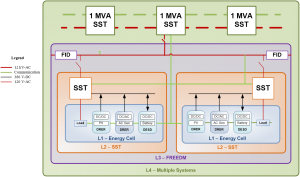Overview
This chapter discusses the high-level architecture of the system where different levels of operation and control are classified and discussed in detail.
The FREEDM System consists of many Solid State Transformers (SST) with Distributed Renewable Energy Resources (DRER) and Distributed Energy Storage Devices (DESD). The SST has three power electronics stages which transfer High Voltage (HV) AC into both Low Voltage (LV) DC and LVAC. These three stages are: Rectifier, Dual Active Bridge (DAB) and Inverter. Standing at a power flow point of view, the rectifier stage converts HVAC into HVDC. The DAB stage takes the HVDC from the rectifier and lowers down its voltage. The inverter converts LVDC into LVAC for the ac micro-grid applications. In the modeling, both the dc micro-grid and the ac micro-grid consist of one Wind DRER, one Photovoltaic (PV) DRER, one DESD, and local Load.

Categorization of levels
The FREEDM architecture is categorized into four levels based on the complexity of the system design and operation
Level 1: Energy Cell (DC Microgrid)
Coordination of local load, generation, and storage on SST secondary for maintaining instantaneous power balance.
Level 2: Single SST
Interaction of a single SST with medium-voltage FREEDM system based on localized measurements and control.
Level 3: FREEDM System
Interaction of multiple SSTs and FIDs within a single FREEDM system based on peer to peer communications and distributed control. Note “1 MVA SST” corresponds to Substation SST.
Level 4: Multiple FREEDM Systems
Interaction of multiple FREEDM systems interconnected to form a medium-voltage distribution system.
